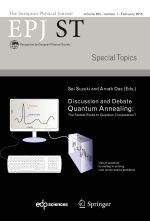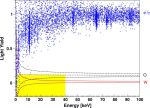News
EPJ D – Graphical abstracts now required in EPJ D
- Details
- Published on 10 February 2015
We are pleased to inform the readers and authors of EPJ D that from now on articles published in the journal will feature a graphical abstract. While it is not meant to provide specific results, this element will serve the purpose of conveying visually the gist of the article, along with the title. Authors may use an item already present in the manuscript or a purpose-made graphic. The use of color is strongly encouraged. Images previously published under the copyright of other publishers cannot be considered.
EPJ A Highlight - Mechanisms of two-proton emission seen in three-body correlations
- Details
- Published on 10 February 2015

Hitherto three-body correlations between decay products of nuclear resonances, unstable to the emission of two neutrons have been a very effective tool in the analysis of GSI-experiments on 5H, 10He, 13Li, and 14Be. Here the first report is given about the mechanisms for two-proton emission from states in 16Ne, representing the presently most complete study of this nucleus. One-neutron knockout from 17Ne populated the 16Ne(g.s.) (Er=1.39 MeV, Γ=0.08 MeV) above the 14O+p+p threshold, and resonances at Er=3.22 MeV and 7.57 MeV. The decay mechanisms were revealed analysing three-body energy correlations in the 14O+p+p system. It was found that the 16Ne(g.s.) undergoes a democratic three-body decay. In contrast to this, the 16Ne(21+) state emits protons through the 15F(g.s.) sequentially. The decay of 7.57 MeV state is well-described assuming emission of a proton from the d5/2 shell to 15F(5/2+), which decays by d5/2 proton emission to 14O(g.s.). By using R-matrix analysis and mirror symmetry this state was unambiguously identified as the third 2+ state in 16Ne.
J. Marganiec et al. (2014), Studies of continuum states in 16Ne using three-body correlation techniques, European Physical Journal A 51: 9, DOI 10.1140/epja/i2015-15009-0
EPJ Plus Highlight - Ultrafast laser for crafting ever thinner solar cells
- Details
- Published on 10 February 2015

Solar-cell efficiency depends on how thin it can be manufactured. Now, a new model exploits femtosecond laser sources to get higher efficiency at lower cost
The race for ever more efficient and cheaper solar cells tests the limits of manufacturing. To achieve this, photovoltaic solar cells need to become thinner and are made of more complex inner structures. Now, Italian scientists have investigated and expanded a model elucidating the dominant physical processes when ultra-fast lasers are used in manufacturing solar cells to these specifications. An article by Alberto Gurizzan and Paolo Villoresi from the University of Padova in Italy detailing this model has now been published in EPJ Plus.
EPJ ST Highlight - Analogue quantum computers: still wishful thinking?
- Details
- Published on 09 February 2015

Many challenges lie ahead before quantum annealing, the analogue version of quantum computation, contributes to solve combinatorial optimisation problems
Traditional computational tools are simply not powerful enough to solve some complex optimisation problems, like, for example, protein folding. Quantum annealing, a potentially successful implementation of analogue quantum computing, would bring about an ultra-performant computational method. A series of reviews in this topical issue of EPJ ST, guest-edited by Sei Suzuki from Saitama Medical University, Japan, and Arnab Das from the Indian Association for the Cultivation of Science, Kolkota, India, focuses on the state of the art and challenges in quantum annealing. This approach, if proven viable, could greatly boost the capabilities of large-scale simulations and revolutionise several research fields, from biology to economics, medicine and material science.
EPJ B Highlight - Probing qualities at the tips of nanocones
- Details
- Published on 01 February 2015

New understanding of electron behaviour at the tips of carbon nanocones could help provide candidates for use as a novel probe in atomic force microscopy
One of the ways of improving electrons manipulation is though better control over one of their inner characteristics, called spin. This approach is the object of an entire field of study, known as spintronics. Now, Richard Pincak from the Slovak Academy of Sciences and colleagues have just uncovered new possibilities for manipulating the electrons on the tips of graphitic nanocones. Indeed, in a study published in EPJ B, they have shown that because the tip area offers the greatest curvature, it gives rise, in the presence of defects, to an enhanced manifestation of a phenomenon called spin-orbit interaction. This, in turn, affects its electronic characteristics. These nanocones could thus become candidates for a new type of scanning probe in atomic force microscopy.
EPJ D Highlight - The power of light-matter coupling
- Details
- Published on 28 January 2015

A theoretical study shows that strong ties between light and organic matter at the nanoscale open the door to modifying these coupled systems’ optical, electronic or chemical properties.
Light and matter can be so strongly linked that their characteristics become indistinguishable. These light-matter couplings are referred to as polaritons. Their energy oscillates continuously between both systems, giving rise to attractive new physical phenomena. Now, scientists in France have explained why such polaritons can remain for an unusual long time at the lowest energy levels, in such a way that alters the microscopic and macroscopic characteristics of their constituting matter. These findings thus pave the way for optical, electronic and chemical applications. The work has been published in EPJ D by Antoine Canaguier-Durand from the University of Strasbourg, France, and colleagues.
EPJ Data Science Highlight - Towards a scientific process freed from systemic bias
- Details
- Published on 25 January 2015

Large-scale analysis of bibliographic data can help us better understand the complex social processes in science and provide more accurate evaluation methods
Research on how science works—the science of science—can benefit from studying the digital traces generated during the research process, such as peer-reviewed publications. This type of research is crucial for the future of science and that of scientists, according to Frank Schweitzer, Chair of Systems Design at ETH Zurich, in Switzerland. Indeed, quantitative measures of scientific output and success in science already impact the evaluation of researchers and the funding of proposals. He shares his views in an Editorial spearheading a thematic series of articles entitled “Scientific networks and success in science”, published in EPJ Data Science. There, Schweitzer notes, “it is appropriate to ask whether such quantitative measures convey the right information and what insights might be missing.”
EPJ C Highlight - Shedding new light on dark matter
- Details
- Published on 13 January 2015

Study shows significant progress in determining what dark matter is not made of, thanks to much more sensitive detectors capable of identifying the presence of elusive particles, called WIMPs
According to astronomical observations, dark matter constitutes a five times greater proportion of the universe than ordinary matter, which only makes up 5% of the matter in the universe. The remaining 70% of the universe is known as dark energy. However, we still do not know what dark matter is made of. Indeed, none of the known elementary particles fulfil the criteria to explain dark matter. One theory suggests that it consists of as yet unknown elementary particles that interact only very weakly with ordinary matter, fittingly called WIMPs (Weakly Interacting Massive Particles). Now, members of the CRESST (Cryogenic Rare Event Search with Superconducting Thermometers) collaboration have analysed recent data showing what dark matter is not made of, from a new kind of detector for such particles. This work has recently been published in EPJ C.
EPJ B Highlight - From stained glass to novel optical effect
- Details
- Published on 13 January 2015

Physicists investigate hybrid nanostructures made of semiconductor and metal components, yielding novel electronic and optical characteristics when exposed to light
Coloured stained-glass windows in churches typically contain metallic nanoparticles. They illustrate how light interacts with matter in a specific way at nanoscales. Depending on the material, different types of excitations arise within the inner structure of the material. By combining two different nanostructures, physicists expect the best electronic and optical response from each material. A team of Austrian scientists has just produced a model describing the optical properties of a matchstick-shaped hybrid nanoparticle, made of a cadmium sulphide semiconductor rod attached to a metallic gold cap. The results have been published in EPJ B by physicist Jakob Ebner and colleagues from the Karl Franzens University in Graz. Similar light-matter interactions have been observed in related systems, such as graphene. Better understanding such interactions could ultimately help in enhancing the sensitivity of chemical or biological detectors, as well as in increasing the efficiency of solar cells.
EPJB Highlight - Picosecond-range control over information processing
- Details
- Published on 12 January 2015

Optical manipulation is key to reaching the necessary speed to control the furtive underlying physical mechanism used in quantum information processing
Quantum computing will, one day, bring quicker information processing. One of the keys to such speed is being able to control the short-lived physical phenomenon holding quantum information, also known as quantum bits (qubits). A new study presents a novel optical manipulation technique to control one possible kind of qubit—represented, in this case, by polarised electron spins—exposed to an ultra-short pulsed laser in the picosecond-range. Jorge Budagosky and Alberto Castro from the University of Zaragoza, Spain, have tested this novel optics approach using a quantum dot—nanoscopic artificial structures with a small number of electrons—in a study published in EPJ B.




